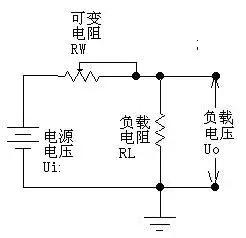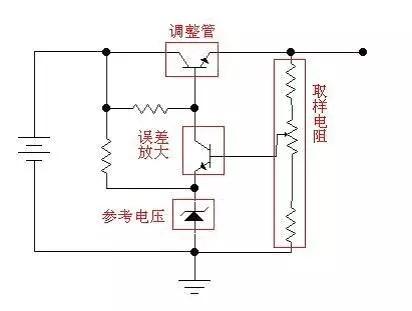Deep analysis of linear regulated power supply, why small devices play a significant role
Time:2023-09-05
Views:711
According to the working state of the regulating tube, we often divide the regulated power supply into two categories: linear regulated power supply and switch regulated power supply. In addition, there is a small power supply that uses a voltage regulator.


The linear regulated power supply mentioned here refers to a DC regulated power supply that operates in a linear state with an adjustment tube. The adjustment tube works in a linear state, which can be understood as follows: RW (see analysis below) is continuously variable, that is, linear. In switching power supplies, the switch transistor (commonly referred to as the adjustment transistor in switching power supplies) operates in two states: on - with very low resistance; Off - The resistance is high. The tube working in the on/off state is clearly not in a linear state.
Linear regulated power supply is a relatively early type of DC regulated power supply. The characteristics of linear regulated DC power supply are: the output voltage is lower than the input voltage; Fast response speed and small output ripple; Low noise generated by work; Low efficiency (LDO, which is often seen nowadays, appears to solve efficiency problems); High heat generation (especially high-power power sources) indirectly increases thermal noise to the system.
Working principle: Let‘s first use the following diagram to illustrate the principle of voltage regulation in a linear regulated power supply.
As shown in the following figure, the variable resistor RW and the load resistor RL form a voltage divider circuit, with an output voltage of:
Uo=Ui × RL/(RW+RL), therefore, by adjusting the size of RW, the output voltage can be changed. Please note that in this equation, if we only look at the value change of the adjustable resistor RW, the output of Uo is not linear, but if we look at RW and RL together, it is linear. Also note that our diagram does not depict the RW lead end as connected to the left, but rather on the right. Although there may not be much difference in formula, drawing it on the right precisely reflects the concepts of "sampling" and "feedback" - in reality, the vast majority of power sources work in sampling and feedback modes, and feedforward methods are rarely used, or simply auxiliary methods.
Let‘s continue: if we replace the variable resistor in the figure with a transistor or field-effect transistor, and control the resistance value of this "variable resistor" by detecting the output voltage, so that the output voltage remains constant, we achieve the goal of voltage stabilization. This transistor or field-effect transistor is used to adjust the voltage output size, so it is called an adjustment transistor.
As shown in Figure 1, the regulator is called a series regulated power supply because it is connected in series between the power supply and the load. Correspondingly, there is a parallel regulated power supply, which adjusts the output voltage by paralleling the regulating tube with the load. A typical reference voltage regulator TL431 is a type of parallel regulated power supply. The meaning of parallel connection is to ensure the "stability" of the emitter voltage of the attenuation amplifier tube through shunt, as shown in Figure 2. Perhaps this figure does not immediately indicate that it is "parallel", but upon closer inspection, it is indeed the case. However, it should be noted that the voltage regulator used here operates in its nonlinear region. Therefore, if it is considered a power source, it is also a nonlinear power source. For the convenience of everyone‘s understanding, let‘s look for a reasonably suitable diagram later until we can understand it concisely.
Due to the fact that the adjustment tube acts as a resistor and generates heat when current flows through the resistor, the adjustment tube operating in a linear state generally generates a large amount of heat, resulting in low efficiency. This is one of the main drawbacks of linear regulated power supplies. For a more detailed understanding of linear regulated power supplies, please refer to the analog electronic circuit textbook. Our main purpose here is to help everyone clarify these concepts and their relationships.
Detailed explanation of the working principle of linear regulated power supply

Figure 1
Generally speaking, a linear regulated power supply consists of several basic components, such as an adjustment transistor, reference voltage, sampling circuit, and error amplification circuit. In addition, it may also include some parts such as protection circuits, starting circuits, etc. The following diagram is a relatively simple schematic diagram of a linear regulated power supply (schematic diagram, omitting filtering capacitors and other components). The sampling resistor samples the output voltage and compares it with the reference voltage. The comparison result is amplified by the error amplification circuit, and the conduction degree of the adjustment tube is controlled to maintain stable output voltage.
Detailed explanation of the working principle of linear regulated power supply

Figure 2
The commonly used linear series regulated power supply chips include: 78XX series (positive voltage type), 79XX series (negative voltage type) (in actual products, XX is represented by numbers, and the output voltage is what XX is. For example, 7805 has an output voltage of 5V); LM317 (adjustable positive voltage type), LM337 (adjustable negative voltage type); 1117 (Low voltage differential type, there are multiple models, and the voltage value is represented by the tail. For example, 1117-3.3 is 3.3V, and 1117-ADJ is adjustable).
|
Disclaimer: This article is transferred from other platforms and does not represent the views and positions of this site. If there is any infringement or objection, please contact us to delete it. thank you! |











